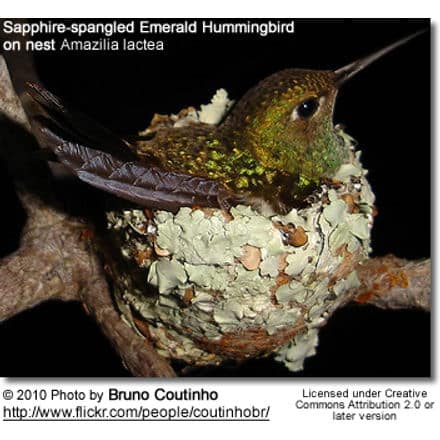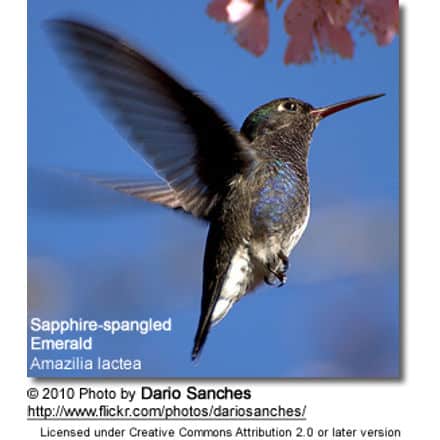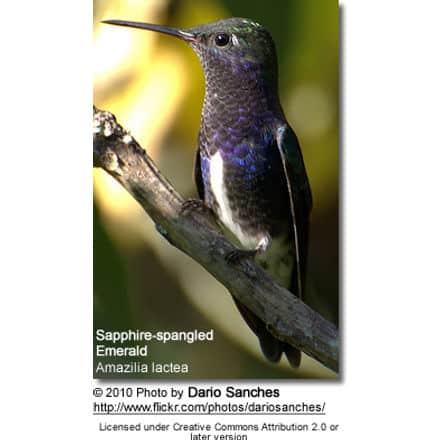Sapphire-spangled Emeralds
The Sapphire-spangled Emeralds (Amazilia lactea) – also known as Tepui Emeralds or Bartlett’s Emeralds – are South American hummingbirds.
Distribution / Habitat
They occur naturally in Venezuela, Peru, Bolivia, and central and southeast Brazil (from the Amazon south to Santa Catarina). There are some unconfirmed records from east Ecuador.
They are relatively common in at least part of their natural range.
They inhabit mountainous regions, forest edges, and gardens in urban areas.
Subspecies and Distribution:
- Sapphire-spangled Emerald(Amazilia lactea lactea – Lesson, 1832) – Nominate Race
- Range: Central and southern Brazil from southern Bahia to São Paul
- Tepui Emerald – Amazilia lactea zimmeri(Gilliard, 1941)
- Range: Southeastern Venezuela
- Bartlett’s Emerald – Amazilia lactea bartletti (Gould, 1866)
- Range: Eastern and southeastern Peru and northern Bolivia; doubtfully extreme eastern Ecuador
Alternate (Global) Names
Chinese: ???? … Czech: Kolibrík safírový, kolib?ík safírový … Danish: Safiramazilie … Dutch: Saffieramazilia … German: Saphir Amazilie, Saphiramazilie … Finnish: Purppurakurkkukolibri … French: Ariane saphirine, Émeraude à saphirs, Polyerata lactea … Italian: Amazilia ornata di zaffiro, Smeraldo macchiezaffiro … Japanese: shirosujiemerarudohachidori … Norwegian: Fiolstrupekolibri … Polish: szmaragdzik mleczny … Portuguese: Beija-flor-de-peito-azul … Russian: ?????????? ???????? … Slovak: kolibrík jagavý … Spanish: Amazilia Zafirina, Diamante de Pecho Zafiro, Diamante Pechizafiro … Swedish: Violettstrupsmaragd
Description
Sapphire-spangled Emeralds were named for the bright “sapphire” blue chest and chin coloration. The plumage below is a green-blue abdomen with a white stripe running down the middle of its torso. The bill is almost straight; with a black upper mandible (bill) and a pink lower mandible. Males and females look alike.
Similar Species:
They resemble the Glittering-throated Emerald; but can be identified by the glittering sapphire violet-blue coloration on the throat, chest, and the sides of the neck.
Hummingbird Resources
- Hummingbird Information
- Hummingbird Amazing Facts
- Attracting Hummingbirds to Your Garden
- Hummingbird Species
- Feeding Hummingbirds

Nesting / Breeding
In Brazil, the Sapphire-spangled Hummingbirds typically breed in the spring (September – December).
Hummingbirds are solitary in all aspects of life other than breeding, and the male’s only involvement in the reproductive process is the actual mating with the female. They neither live nor migrate in flocks, and there is no pair bond for this species. Males court females by flying in a U-shaped pattern in front of them. He will separate from the female immediately after copulation. One male may mate with several females. In all likelihood, the female will also mate with several males. The males do not participate in choosing the nest location, building the nest, or raising the chicks.
The female Sapphire-spangled Emerald is responsible for building the cup-shaped nest out of plant fibers woven together and green moss on the outside for camouflage in a protected location in a shrub, bush, or tree. She lines the nest with soft plant fibers, animal hair, and feathers down, and strengthens the structure with spider webbing and other sticky material, giving it an elastic quality to allow it to stretch to double its size as the chicks grow and need more room. The nest is typically found on a low, thin horizontal branch.
The average clutch consists of two white eggs, which she incubates alone, while the male defends his territory and the flowers he feeds on. The young are born blind, immobile, and without any down.
The female alone protects and feeds the chicks with regurgitated food (mostly partially digested insects since nectar is an insufficient source of protein for the growing chicks). The female pushes the food down the chicks’ throats with her long bill directly into their stomachs.
As is the case with other hummingbird species, the chicks are brooded only the first week or two and are left alone even on cooler nights after about 12 days – probably due to the small nest size. The chicks leave the nest when they are about 19 days old.
Diet / Feeding
Sapphire-spangled Emeralds primarily feed on nectar taken from a variety of brightly colored, scented small flowers of trees, herbs, shrubs, and epiphytes.








